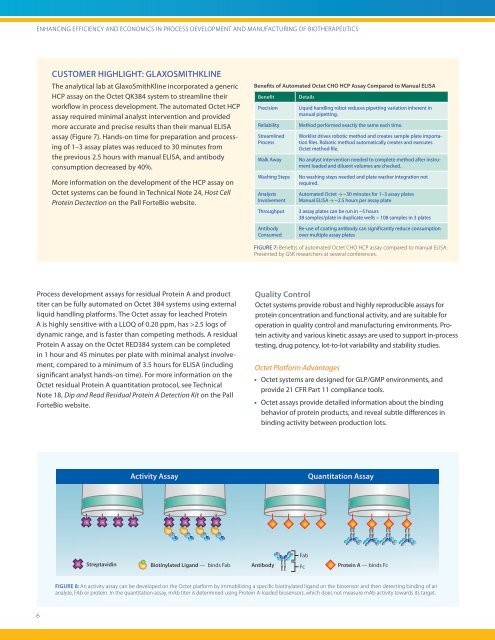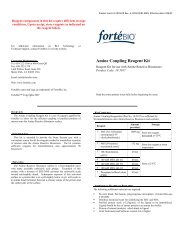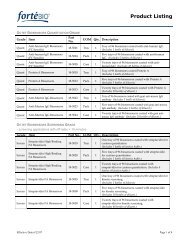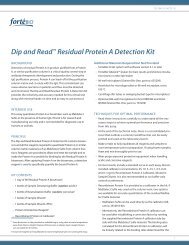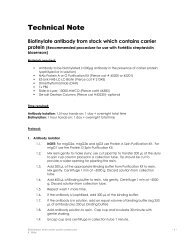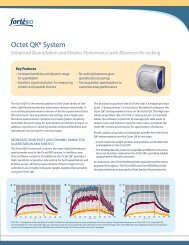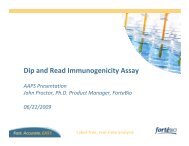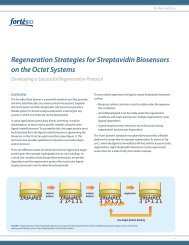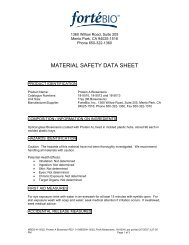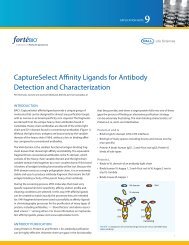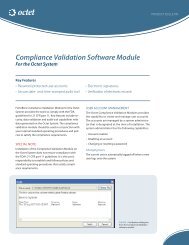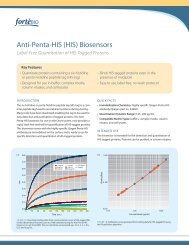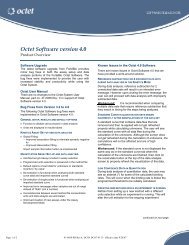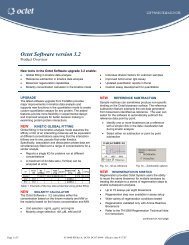Enhancing Efficiency and Economics in Process ... - ForteBio
Enhancing Efficiency and Economics in Process ... - ForteBio
Enhancing Efficiency and Economics in Process ... - ForteBio
Create successful ePaper yourself
Turn your PDF publications into a flip-book with our unique Google optimized e-Paper software.
<strong>Enhanc<strong>in</strong>g</strong> <strong>Efficiency</strong> <strong>and</strong> <strong>Economics</strong> <strong>in</strong> <strong>Process</strong> Development <strong>and</strong> Manufactur<strong>in</strong>g of Biotherapeutics<br />
CUSTOMER HIGHLIGHT: GLAXOSMITHKLINE<br />
The analytical lab at GlaxoSmithKl<strong>in</strong>e <strong>in</strong>corporated a generic<br />
HCP assay on the Octet QK384 system to streaml<strong>in</strong>e their<br />
workflow <strong>in</strong> process development. The automated Octet HCP<br />
assay required m<strong>in</strong>imal analyst <strong>in</strong>tervention <strong>and</strong> provided<br />
more accurate <strong>and</strong> precise results than their manual ELISA<br />
assay (Figure 7). H<strong>and</strong>s-on time for preparation <strong>and</strong> process<strong>in</strong>g<br />
of 1–3 assay plates was reduced to 30 m<strong>in</strong>utes from<br />
the previous 2.5 hours with manual ELISA, <strong>and</strong> antibody<br />
consumption decreased by 40%.<br />
More <strong>in</strong>formation on the development of the HCP assay on<br />
Octet systems can be found <strong>in</strong> Technical Note 24, Host Cell<br />
Prote<strong>in</strong> Dectection on the Pall <strong>ForteBio</strong> website.<br />
Benefits of Automated Octet CHO HCP Assay Compared to Manual ELISA<br />
Benefit<br />
Precision<br />
Reliability<br />
Streaml<strong>in</strong>ed<br />
<strong>Process</strong><br />
Walk Away<br />
Wash<strong>in</strong>g Steps<br />
Analysts<br />
Involvement<br />
Throughput<br />
Details<br />
Liquid h<strong>and</strong>l<strong>in</strong>g robot reduces pipett<strong>in</strong>g variation <strong>in</strong>herent <strong>in</strong><br />
manual pipett<strong>in</strong>g.<br />
Method performed exactly the same each time.<br />
Worklist drives robotic method <strong>and</strong> creates sample plate importation<br />
files. Robotic method automatically creates <strong>and</strong> executes<br />
Octet method file.<br />
No analyst <strong>in</strong>tervention needed to complete method after <strong>in</strong>strument<br />
loaded <strong>and</strong> diluent volumes are checked.<br />
No wash<strong>in</strong>g steps needed <strong>and</strong> plate washer <strong>in</strong>tegration not<br />
required.<br />
Automated Octet ~30 m<strong>in</strong>utes for 1–3 assay plates<br />
Manual ELISA ~2.5 hours per assay plate<br />
3 assay plates can be run <strong>in</strong> ~5 hours<br />
38 samples/plate <strong>in</strong> duplicate wells > 108 samples <strong>in</strong> 3 plates<br />
Antibody<br />
Consumed<br />
Re-use of coat<strong>in</strong>g antibody can significantly reduce consumption<br />
over multiple assay plates<br />
Figure 7: Benefits of automated Octet CHO HCP assay compared to manual ELISA.<br />
Presented by GSK researchers at several conferences.<br />
<strong>Process</strong> development assays for residual Prote<strong>in</strong> A <strong>and</strong> product<br />
titer can be fully automated on Octet 384 systems us<strong>in</strong>g external<br />
liquid h<strong>and</strong>l<strong>in</strong>g platforms. The Octet assay for leached Prote<strong>in</strong><br />
A is highly sensitive with a LLOQ of 0.20 ppm, has >2.5 logs of<br />
dynamic range, <strong>and</strong> is faster than compet<strong>in</strong>g methods. A residual<br />
Prote<strong>in</strong> A assay on the Octet RED384 system can be completed<br />
<strong>in</strong> 1 hour <strong>and</strong> 45 m<strong>in</strong>utes per plate with m<strong>in</strong>imal analyst <strong>in</strong>volvement,<br />
compared to a m<strong>in</strong>imum of 3.5 hours for ELISA (<strong>in</strong>clud<strong>in</strong>g<br />
significant analyst h<strong>and</strong>s-on time). For more <strong>in</strong>formation on the<br />
Octet residual Prote<strong>in</strong> A quantitation protocol, see Technical<br />
Note 18, Dip <strong>and</strong> Read Residual Prote<strong>in</strong> A Detection Kit on the Pall<br />
<strong>ForteBio</strong> website.<br />
Quality Control<br />
Octet systems provide robust <strong>and</strong> highly reproducible assays for<br />
prote<strong>in</strong> concentration <strong>and</strong> functional activity, <strong>and</strong> are suitable for<br />
operation <strong>in</strong> quality control <strong>and</strong> manufactur<strong>in</strong>g environments. Prote<strong>in</strong><br />
activity <strong>and</strong> various k<strong>in</strong>etic assays are used to support <strong>in</strong>-process<br />
test<strong>in</strong>g, drug potency, lot-to-lot variability <strong>and</strong> stability studies.<br />
Octet Platform Advantages<br />
• Octet systems are designed for GLP/GMP environments, <strong>and</strong><br />
provide 21 CFR Part 11 compliance tools.<br />
• Octet assays provide detailed <strong>in</strong>formation about the b<strong>in</strong>d<strong>in</strong>g<br />
behavior of prote<strong>in</strong> products, <strong>and</strong> reveal subtle differences <strong>in</strong><br />
b<strong>in</strong>d<strong>in</strong>g activity between production lots.<br />
Activity Assay<br />
Quantitation Assay<br />
Fab<br />
Streptavid<strong>in</strong> Biot<strong>in</strong>ylated Lig<strong>and</strong> — b<strong>in</strong>ds Fab Antibody<br />
Fc<br />
Prote<strong>in</strong> A — b<strong>in</strong>ds Fc<br />
Figure 8: An activity assay can be developed on the Octet platform by immobiliz<strong>in</strong>g a specific biot<strong>in</strong>ylated lig<strong>and</strong> on the biosensor <strong>and</strong> then detect<strong>in</strong>g b<strong>in</strong>d<strong>in</strong>g of an<br />
analyte, FAb or prote<strong>in</strong>. In the quantitation assay, mAb titer is determ<strong>in</strong>ed us<strong>in</strong>g Prote<strong>in</strong> A-loaded biosensors, which does not measure mAb activity towards its target.<br />
6


